Pedagogy is an essential aspect of education that encompasses various teaching and learning strategies. It revolves around creating an engaging and effective learning environment for students, focusing on their needs and promoting their academic growth. By incorporating pedagogical approaches, educators can enhance student learning outcomes and foster a positive and enriching educational experience. In this article, we will explore different pedagogical strategies and their application in modern education.
- Pedagogy involves the theory and practice of teaching and learning.
- Effective pedagogy is learner-centered and maximizes student engagement.
- Various pedagogical strategies, such as active learning and authentic assessment, can enhance the learning process.
- Technology plays a significant role in modern pedagogy, allowing teachers to leverage tools and online platforms.
- Creating inclusive and diverse learning environments is crucial for effective pedagogy.
Understanding Active Learning as an Effective Pedagogical Strategy
Active learning is an engaging and student-centered approach that encourages students to actively participate in the learning process. Rather than passively receiving information, students are actively involved in hands-on activities, discussions, and problem-solving.
By incorporating active learning strategies, educators create a dynamic and interactive learning environment that fosters interaction and collaboration among students.
Active learning promotes deeper understanding and retention as students gain knowledge through active engagement and reflection.
Through active learning, students develop critical thinking, communication, and teamwork skills, essential for success in the modern world.
One effective active learning strategy is group work, where students work together in small groups to solve problems or complete projects. This approach allows for peer-to-peer learning, promoting collaboration and knowledge sharing.
Another active learning technique is classroom discussions, where students share their thoughts, ideas, and perspectives on various topics. These discussions encourage active participation and engagement while fostering a sense of community and inclusivity within the classroom.
Active learning can be implemented across various subjects and grade levels, adapting to different learning styles and preferences. It is particularly effective in promoting conceptual understanding and application of knowledge.
The Benefits of Active Learning
Active learning offers numerous benefits to both students and educators:
- Enhanced engagement: By actively participating in the learning process, students become more engaged and motivated to learn.
- Improved retention: Active learning promotes deeper understanding and retention of concepts through hands-on experiences and reflection.
- Development of critical thinking skills: Through problem-solving activities and discussions, students develop critical thinking skills, enabling them to analyze information and make informed decisions.
- Enhanced collaboration: Group work and classroom discussions foster collaboration and teamwork, preparing students for real-world scenarios that require cooperation and communication.
- Increased student satisfaction: Active learning approaches have been shown to increase student satisfaction with the learning experience, leading to higher levels of academic achievement.
Implementing active learning strategies requires careful planning, creativity, and a commitment to creating an inclusive and student-centered learning environment.
Continued research and innovation in education will further support the use of active learning techniques, ensuring students are equipped with the skills and knowledge required for their future success.
Implementing Authentic Assessment for Meaningful Learning
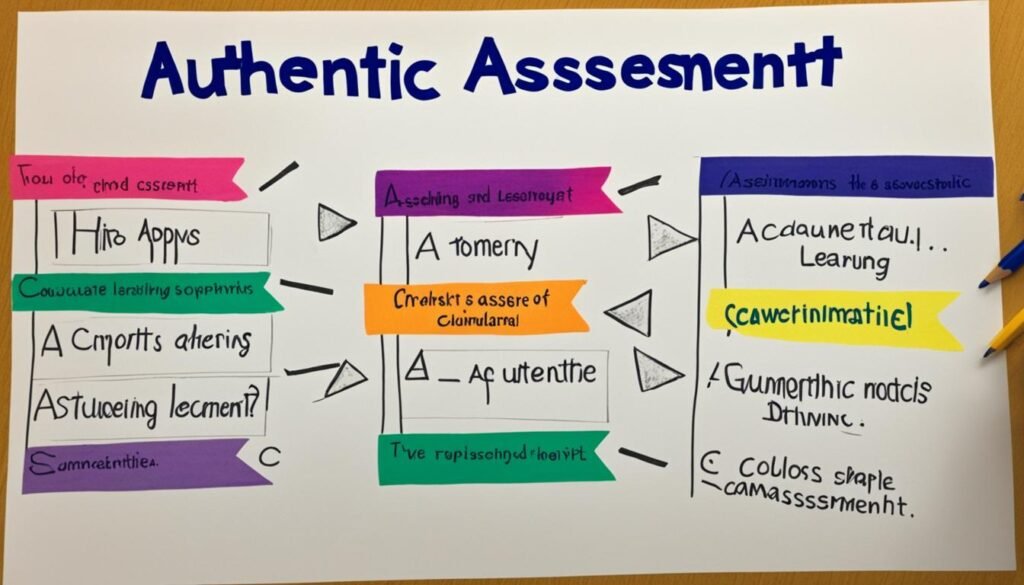
In education, assessment plays a vital role in evaluating students’ skills, knowledge, and understanding. Traditional methods of assessment, such as tests and quizzes, focus primarily on memorization and regurgitation. However, to foster meaningful learning, it is essential to implement authentic assessment strategies that go beyond rote memorization and encourage real-world application of knowledge.
Authentic assessment involves measuring student learning through real-world tasks or applications of knowledge, providing students with the opportunity to showcase their understanding and skills in practical settings. Unlike traditional assessments, which often rely on multiple-choice questions or short answers, authentic assessment prompts students to engage in critical thinking, problem-solving, and meaningful application of concepts.
Real-World Tasks and Projects
One key aspect of authentic assessment is the integration of real-world tasks and projects. By designing assessments that simulate authentic scenarios, students are able to apply their knowledge and skills to solve relevant problems or address meaningful issues. For example, a science project that requires students to design and conduct an experiment related to environmental sustainability allows them to not only demonstrate their understanding of scientific concepts but also develop important research and analytical skills.
Meaningful Application of Knowledge
Authentic assessment also emphasizes the meaningful application of knowledge beyond the classroom. This approach recognizes that true learning occurs when students can transfer what they have learned to real-life situations. By incorporating tasks that mirror the challenges and complexities of the real world, educators can foster a deeper understanding of concepts, as well as develop problem-solving and critical thinking skills that are essential for success beyond academia.
“Authentic assessment allows students to showcase their understanding and skills in practical settings, preparing them for real-world challenges.”
Benefits of Project-Based Learning
Project-based learning (PBL) is an effective instructional approach that aligns well with authentic assessment. PBL engages students in exploring and solving authentic, complex problems, often in collaboration with their peers. This approach promotes meaningful application of knowledge through hands-on projects, encouraging critical thinking, creativity, and communication skills.
Here is an example of a project-based learning strategy that combines authentic assessment:
| Project | Key Skills/Concepts |
|---|---|
| Create a Business Plan | Entrepreneurship, Financial Literacy, Critical Thinking, Communication |
| Design a Sustainable Community | Urban Planning, Environmental Science, Collaboration, Problem-Solving |
| Develop an App Prototype | Computer Science, Design Thinking, User Experience, Presentation |
These project-based learning activities encompass authentic assessment by challenging students to combine various skills, apply knowledge in real-world contexts, and present their findings or solutions. By engaging in these projects, students not only deepen their understanding but also develop essential 21st-century skills that are crucial for success in their future careers.
Implementing authentic assessment strategies aligned with project-based learning creates a dynamic and meaningful learning environment that prepares students for the challenges they will face beyond the classroom. By enabling students to apply their knowledge and skills to authentic, real-world tasks, educators can foster deeper understanding, critical thinking, and problem-solving abilities, ultimately empowering students for success in their future endeavors.
Leveraging Technology for Effective Teaching and Learning

In today’s modern pedagogy, technology plays a vital role in enhancing teaching and learning experiences. Teachers can leverage various tools and strategies to incorporate technology seamlessly into their instructional practices, benefiting both educators and learners. Let’s explore some key technologies that are revolutionizing the field of education.
Artificial Intelligence in Education
Artificial Intelligence (AI) is transforming the way we teach and learn. AI-powered educational tools can provide personalized learning experiences, adapt to individual student needs, and offer real-time feedback. By analyzing data and patterns, AI algorithms can identify students’ strengths and weaknesses, enabling teachers to tailor instruction and interventions accordingly.
Instructional Design and Technology Integration
Instructional design involves carefully planning and creating learning experiences that engage and effectively communicate information to students. Integrating technology in instructional design enhances content delivery, enables interactive learning activities, and promotes student engagement. Multimedia presentations, online assessments, and digital simulations are just a few examples of how technology can be integrated into instructional design.
Online Learning Platforms
Online learning platforms provide flexible and accessible educational opportunities for students of all ages. These platforms offer a wide range of courses and resources, allowing learners to study at their own pace and convenience. Online learning also fosters collaboration among students through discussion boards, virtual classrooms, and online assessments.
Blended Learning Environments
Blended learning combines traditional face-to-face instruction with online learning components. This approach allows for a more personalized learning experience, as students can engage with content online and participate in interactive activities during in-person class sessions. Blended learning fosters independent learning, critical thinking, and problem-solving skills.
By leveraging technology in pedagogy, educators can maximize the potential of their teaching practices and create engaging learning environments that cater to the diverse needs and preferences of today’s learners.
Creating Engaging Learning Environments with Flexible Seating
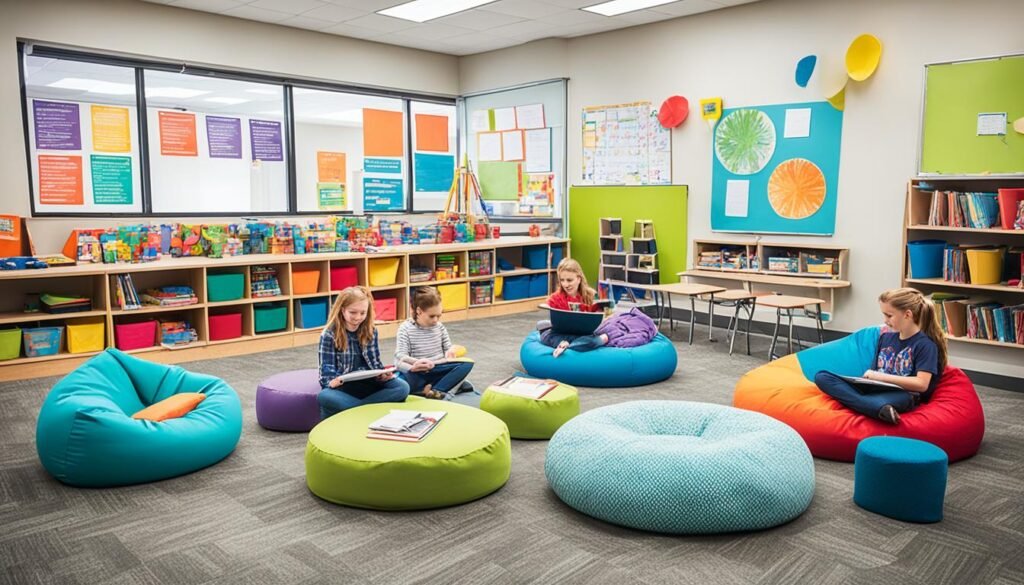
Flexible seating is a student-centered approach that enhances the learning experience by providing students with options to integrate their auditory, visual, and tactile systems. Unlike traditional classroom setups, flexible seating allows students to choose seating arrangements that best support their individual learning needs and preferences.
By incorporating flexible seating options, such as ergonomic chairs, bean bags, standing desks, and floor cushions, educators can create an environment that promotes active engagement and caters to students’ diverse learning styles. This empowers students to take ownership of their learning and fosters a sense of autonomy and responsibility.
Research has shown that flexible seating can positively impact student-centered learning, as it allows students to choose seating arrangements that align with their learning preferences. For example, some students may prefer a quiet corner with minimal distractions, while others may thrive in a collaborative setting where they can easily interact with their peers.
In addition to facilitating individual preferences, flexible seating also encourages collaboration and communication. Students can easily form small groups or engage in peer discussions, promoting a collaborative learning environment that enhances social skills and problem-solving abilities.
Benefits of Flexible Seating:
- Promotes student-centered learning
- Enhances engagement and active participation
- Supports diverse learning styles
- Fosters collaboration and communication
- Allows students to take ownership of their learning
Implementing flexible seating requires careful planning and consideration of the classroom layout. Educators can create designated learning zones, each designed to cater to specific activities and learning styles. For example, a quiet reading nook can be set up for students who prefer a quieter environment, while a collaborative space can be created for group projects and discussions.
By incorporating flexible seating options and creating an inclusive, student-centered learning environment, educators can empower students to thrive and reach their full potential.
| Benefits of Flexible Seating | Description |
|---|---|
| Promotes student-centered learning | Allows students to choose seating arrangements that align with their learning preferences. |
| Enhances engagement and active participation | Provides a comfortable and engaging learning environment, encouraging students to actively participate in classroom activities. |
| Supports diverse learning styles | Offers a variety of seating options to cater to students’ individual learning preferences and needs. |
| Fosters collaboration and communication | Encourages peer interaction and collaborative work, promoting communication and teamwork. |
| Allows students to take ownership of their learning | Empowers students to make choices and take responsibility for their own learning experiences. |
Applying Case-Based Learning for Real-World Problem Solving

Case-based learning is a highly effective pedagogical approach that relies on real-life examples to engage students in problem-solving and critical thinking. By presenting students with authentic scenarios, case-based learning simulates the challenges they may encounter in real-world situations, equipping them with the necessary skills to develop innovative solutions.
Flipping the Classroom to Maximize Learning Potential
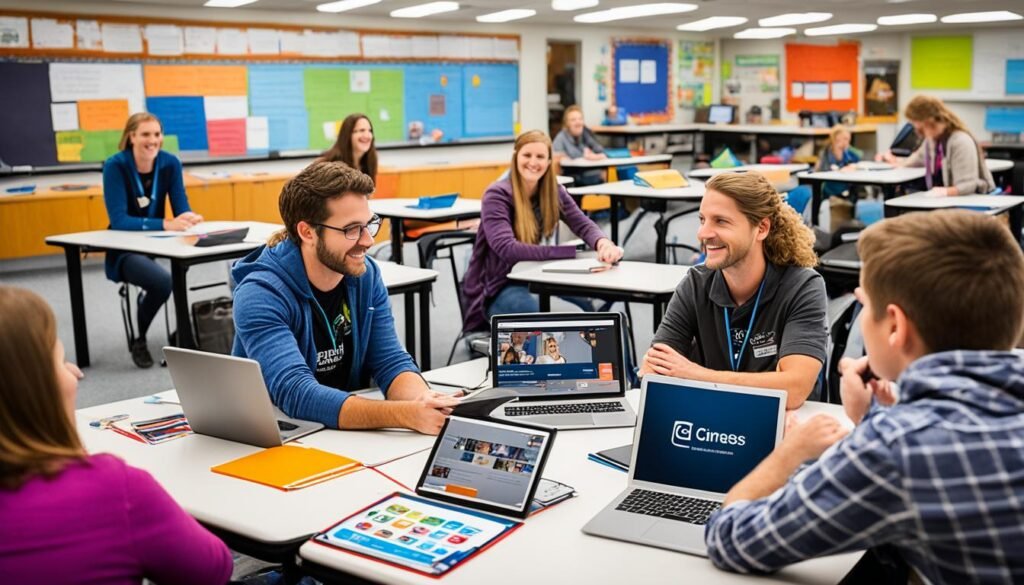
In traditional education, students typically receive lectures and instruction in the classroom and then complete homework and assignments at home. However, a more innovative approach known as the flipped classroom has gained popularity in recent years. The flipped classroom reverses this model, allowing students to gain foundational knowledge outside of class through **online video lectures**.
This approach not only provides students with flexibility in terms of when and where they learn, but it also promotes active learning and collaboration during class time. By engaging with **online video lectures** outside the classroom, students can explore the content at their own pace, allowing for a personalized learning experience. This self-paced learning allows students to review concepts as needed and delve deeper into areas of interest.
During face-to-face class sessions, the focus shifts from passive lecture-style instruction to interactive activities and discussions. Students have the opportunity to work on **hands-on activities**, participate in **outside-classroom exposure** experiences, and engage in **blended learning** with their peers, fostering a deeper understanding of the material.
The Benefits of Flipping the Classroom
Flipping the classroom has numerous benefits for both students and instructors. Here are some key advantages:
- Improved engagement: Students take an active role in their learning, leading to increased engagement and motivation.
- Enhanced understanding: Students can pause, rewind, and review **online video lectures**, enabling a better understanding of complex topics.
- Collaborative learning: Class time is dedicated to discussions and activities that promote collaboration and peer-to-peer learning.
- Individualized instruction: The flipped classroom allows for personalized learning, catering to the unique needs and learning styles of each student.
- Deeper exploration: Students have the opportunity to delve deeper into topics of interest and apply their knowledge in practical scenarios.
Implementing a Flipped Classroom Approach
To implement a successful flipped classroom approach, instructors should consider the following:
- Selecting appropriate **online video lectures** that cover the necessary content and provide clear explanations.
- Providing guidance and support to ensure students have access to technology resources and can navigate the online materials.
- Designing engaging in-class activities that allow students to apply their knowledge, solve problems, and work collaboratively.
- Fostering a supportive learning environment where students feel comfortable asking questions and seeking clarification.
- Evaluating and adjusting the flipped classroom model based on student feedback and learning outcomes.
By flipping the classroom, educators can maximize the learning potential of their students. This innovative approach not only empowers students to take ownership of their learning but also creates a dynamic and interactive classroom environment that fosters deeper understanding, critical thinking, and collaboration.
| Traditional Classroom | Flipped Classroom |
|---|---|
| Lectures delivered in class | Concepts covered through online video lectures |
| Homework and assignments completed at home | In-class activities and discussions |
| Passive learning | Active and collaborative learning |
| Limited time for individualized instruction | Personalized learning and support |
Promoting Inclusion and Diversity in the Learning Experience

Creating an inclusive and diverse learning environment is essential for fostering an enriching educational experience for all students. It involves evaluating course content through a culturally aware lens and designing a curriculum that embraces and celebrates diverse perspectives. By prioritizing inclusion and diversity, educators can create a welcoming and supportive space where every student’s unique needs and experiences are acknowledged and valued.
One key aspect of promoting inclusion and diversity is through curriculum design. Educators should ensure that their curriculum reflects diverse voices, experiences, and cultures. This can be achieved by incorporating literature, history, and artwork from various cultures, as well as addressing social issues and promoting empathy. By doing so, students are exposed to a broader range of ideas, perspectives, and lived experiences, which cultivates a more culturally aware and inclusive learning environment.
Addressing Student Experiences
“Inclusion is not just about having diverse students in the classroom; it’s about creating an environment where their experiences are recognized, respected, and celebrated.”
– Dr. Maya Johnson, Professor of Education
Addressing student experiences is another crucial aspect of promoting inclusion and diversity. Educators should create opportunities for students to share their unique backgrounds, stories, and perspectives. This can be done through class discussions, group projects, and personal reflections. By actively listening to and validating these experiences, educators can foster a sense of belonging and create a safe space for students to express themselves.
Additionally, educators should be aware of and responsive to the unique needs of diverse populations of students. This includes considering factors such as ethnicity, race, gender identity, socioeconomic status, and disability. By understanding and accommodating these needs, educators can create a more equitable and effective learning environment where all students have an equal opportunity to succeed.
Benefits of Inclusion and Diversity
Promoting inclusion and diversity in the learning experience has numerous benefits for students. Not only does it contribute to a more comprehensive understanding of the world and its complexities, but it also cultivates critical thinking, empathy, and cultural competency. Students who learn in an inclusive and diverse environment are better equipped to engage with the broader society and navigate the complexities of an increasingly interconnected world.
In addition, students from marginalized backgrounds often feel more comfortable and empowered in inclusive and diverse learning environments. When students see themselves represented and their contributions valued, it fosters a sense of belonging and confidence, leading to increased motivation and academic success.
Using Mind Mapping to Enhance Conceptual Understanding

When faced with complex and challenging concepts, students often struggle to grasp the underlying relationships and connections. This is where mind mapping comes in as a powerful strategy to enhance conceptual understanding. Through the use of visual diagrams, students can capture, organize, and analyze information in a structured and meaningful way.
Mind mapping allows students to break down difficult concepts into smaller, manageable components. By creating a visual representation of ideas, students can identify key themes, relationships, and supporting evidence. This process not only helps with comprehension but also promotes critical thinking and analysis.
Visualization is a key aspect of mind mapping. By representing information in a visual format, students engage their visual and spatial intelligence, enabling them to see patterns and connections that may not be immediately apparent in traditional text-based formats. This enhances their ability to make sense of complex information and strengthens their overall understanding.
Moreover, mind mapping encourages active engagement with the content. Students actively participate in the process of mapping out their thoughts and ideas, which in turn fosters a deeper level of engagement and ownership over their learning. They become more actively involved in the learning process, making it more meaningful and memorable.
“Mind mapping allows students to break down difficult concepts into smaller, manageable components.”
In addition to promoting conceptual understanding, mind mapping also supports other essential skills such as organization, brainstorming, and creativity. Students can use mind maps to brainstorm ideas, plan projects, and outline their thoughts before diving into detailed assignments.
Example of a Mind Map:
Take a look at the following mind map that illustrates the interconnected concepts of mind mapping, visualization, analysis, and difficult concepts:
| Mind Mapping | Visualization | Analysis | Difficult Concepts |
|---|---|---|---|
| Visual organization | Engages visual intelligence | Identifies patterns | Tackles complex ideas |
| Promotes critical thinking | Supports spatial intelligence | Develops analytical skills | Enhances comprehension |
| Active engagement | Strengthens understanding | Encourages reflective thinking | Facilitates meaningful learning |
As you can see, mind mapping serves as an effective tool for enhancing the understanding of difficult concepts. By visually representing information and encouraging active engagement, it supports students in making sense of complex ideas and strengthens their overall learning experience.
Addressing the Needs of Freshmen Students for a Successful Transition
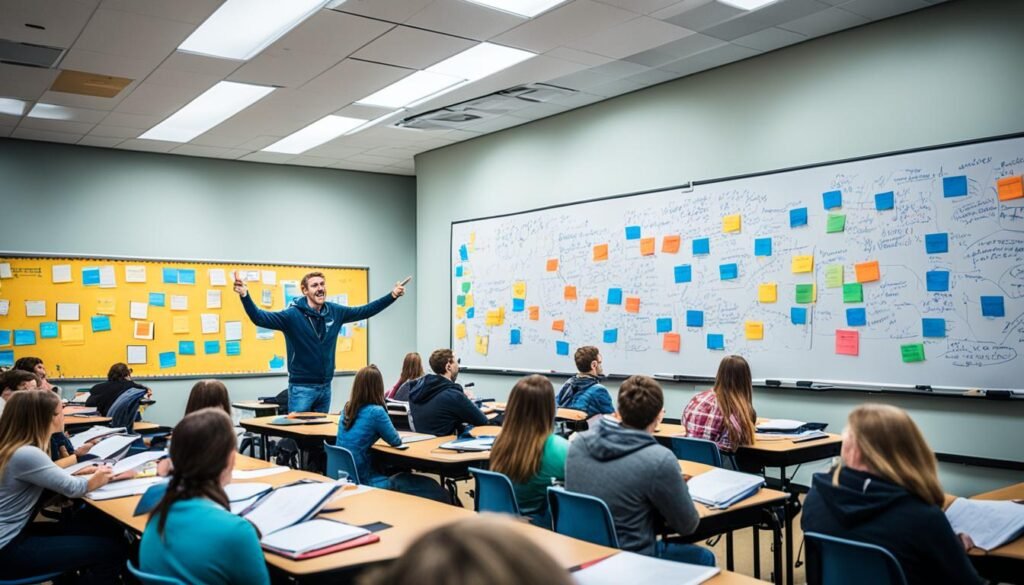
Transitioning from high school to higher education can be a significant milestone for freshmen students. As they embark on this new chapter, it is crucial to implement effective teaching strategies that not only meet their unique needs but also aid in a successful transition to college life. Understanding the diverse educational backgrounds and experiences of freshmen students is essential in providing the necessary support to help them navigate this new academic environment.
Recognizing Diverse Educational Backgrounds
Freshmen students enter college with a wide range of educational backgrounds. Some may have completed rigorous advanced placement courses in high school, while others may have had limited access to academic resources. Recognizing this diversity is key in designing instructional approaches that cater to their individual learning experiences.
By taking into account their educational backgrounds, educators can better address any knowledge or skill gaps and provide additional support where needed. This ensures that all freshmen students have an equal opportunity to succeed academically and thrive in their new learning environment.
Aiding with the Transition Process
The transition from high school to college brings about various challenges for freshmen students. They may encounter differences in instructional methods, expectations, and workload. To facilitate a smooth transition, it is important for educators to provide guidance and resources that help freshmen students adjust to their new academic expectations.
Creating a supportive and inclusive learning environment is vital in assisting freshmen students during this transition period. Providing clear guidelines, setting realistic academic expectations, and offering access to academic support services can help alleviate any anxieties and help freshmen students feel more confident in their abilities.
Meeting Academic Expectations
One of the key aspects of supporting freshmen students is helping them meet the academic expectations of higher education. This involves equipping them with the necessary skills for success and fostering a sense of accountability for their own learning.
By incorporating active learning strategies, such as group discussions, hands-on activities, and critical thinking exercises, educators can engage freshmen students in their learning process. This not only enhances their understanding of course materials but also encourages them to take ownership of their academic journey.
Moreover, providing regular feedback and opportunities for self-reflection can help freshmen students assess their progress, identify areas for improvement, and develop effective study habits. This proactive approach empowers them to take control of their learning and navigate the challenges of higher education.
Supporting Freshmen Classes: Meeting the Challenge
Addressing the needs of freshmen students requires an intentional and student-centered approach. By recognizing their diverse educational backgrounds, aiding with the transition process, and helping them meet academic expectations, educators can support freshmen students in their successful transition to higher education.
Implementing effective teaching strategies that foster engagement, support, and growth will not only enhance the learning experience of freshmen students but also set them on a path to academic success throughout their college journey.
Implementing Teamwork and Collaboration for Enhanced Learning
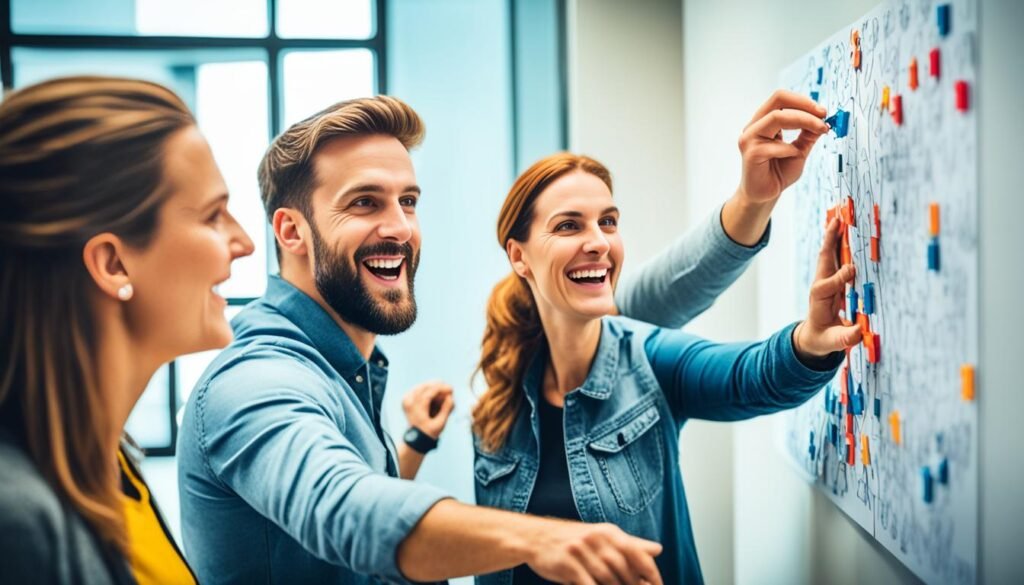
Teamwork and collaboration are essential elements of effective pedagogy that promote engagement and enhanced learning outcomes. By working together in small groups with shared goals, students develop crucial skills in teamwork and collaboration that are valuable in both academic and professional settings.
When students engage in teamwork and collaboration, they actively participate in the learning process, allowing for a deeper understanding of the subject matter. Through shared discussions, brainstorming sessions, and group projects, students have the opportunity to exchange ideas, challenge one another’s perspectives, and collectively solve problems. This collaborative environment encourages critical thinking, creativity, and the exploration of diverse viewpoints.
One effective way to facilitate teamwork and collaboration is to assign group projects that require students to work together towards a common objective. By collaborating in small groups, students can tap into their individual strengths, learn from one another, and develop problem-solving skills. This approach also fosters a sense of responsibility, motivation, and accountability among students, as they rely on one another to achieve their shared goals.
Moreover, teamwork and collaboration prepare students for future professional environments in which these skills are highly valued. In today’s interconnected world, many industries require employees to work collaboratively in diverse teams, making effective teamwork a crucial attribute. By incorporating teamwork and collaboration in the classroom, educators better equip students for future success in their careers.
Benefits of Teamwork and Collaboration:
- Foster a sense of belonging and community: Working in teams helps students develop a supportive network and creates a sense of belonging within the classroom.
- Promote active learning: Collaboration encourages students to actively engage with the material, leading to a deeper understanding of the subject matter.
- Enhance problem-solving skills: Through collaboration, students learn to approach problems from different angles and consider diverse perspectives, leading to innovative solutions.
- Develop interpersonal and communication skills: Working in teams allows students to refine their interpersonal and communication skills, such as active listening and effective verbal and non-verbal communication.
- Cultivate leadership skills: Collaboration provides opportunities for students to take on leadership roles within their groups, fostering the development of leadership abilities.
By implementing teamwork and collaboration in the classroom, educators can create a dynamic and enriching learning environment that prepares students for academic success and future professional endeavors.
Also Read : American University Admission: A Step-by-Step Guide
Conclusion
Pedagogy plays a crucial role in creating effective teaching practices that enhance student engagement and promote positive learning outcomes. By implementing a diverse range of pedagogical strategies, such as active learning, authentic assessment, and technology integration, educators can greatly impact the learning experience for students.
Active learning encourages students to take an active role in the learning process, fostering their interaction, engagement, and reflection. Authentic assessment goes beyond traditional testing methods, allowing students to demonstrate their understanding and skills through real-world tasks and applications. Technology integration enables teachers to leverage tools like artificial intelligence and online platforms to enhance teaching and learning.
As the needs of learners continue to evolve, it is important for educators to continually explore and adapt their pedagogical approaches. By staying up-to-date with the latest practices and incorporating new strategies, educators can ensure that they are effectively meeting the needs of their students and promoting meaningful learning experiences.
FAQs
Q: What is pedagogy and why is it important in education?
A: Pedagogy refers to the methods and strategies used in teaching and education. It is important in education as it helps students learn effectively, achieve learning goals, and enhance the quality of education.
Q: What is the significance of pedagogy approach in teaching?
A: The pedagogy approach in teaching focuses on providing effective learning experiences for students. It involves using innovative teaching and learning methods to help students understand and retain information better.
Q: What are some common types of pedagogy used in education?
A: Some common types of pedagogy include constructivist pedagogy, social pedagogy, critical pedagogy, and culturally responsive pedagogy. Each type emphasizes different teaching methods and approaches to education.
Q: How does pedagogy of the oppressed relate to modern-day pedagogy?
A: Pedagogy of the oppressed, a concept introduced by Paulo Freire, focuses on empowering learners and promoting critical thinking. This approach has influenced modern-day pedagogy by emphasizing the importance of student-centered learning and social justice in education.
Q: What role do teachers and students play in the pedagogy process?
A: Teachers play a key role in designing and implementing pedagogical strategies, while students are actively involved in the learning process. Pedagogy involves a collaborative effort between teachers and students to facilitate effective learning outcomes.
Q: How can pedagogy help students with different learning styles?
A: Pedagogy can cater to students with different learning styles by incorporating diverse teaching methods and approaches. For example, Gardner’s theory of multiple intelligences can be used to design pedagogical strategies that accommodate various learning preferences.
Q: What is the connection between pedagogy and improving learning outcomes?
A: Pedagogy plays a crucial role in improving learning outcomes by providing structured learning experiences, promoting student engagement, and fostering a deeper understanding of the subject matter. Effective pedagogical strategies can lead to enhanced student performance and academic success.
Q: What is pedagogy?
A: Pedagogy refers to the method and practice of teaching, especially as an academic subject or theoretical concept.
Q: What is the importance of pedagogy in teaching?
A: Pedagogy plays a crucial role in shaping how students learn and understand concepts, making it essential for effective teaching and learning outcomes.
Q: How do teaching methods relate to pedagogy?
A: Teaching methods are the practical applications of pedagogical approaches, as they determine how information is presented and how students engage with the material.
Q: What is critical pedagogy?
A: Critical pedagogy is an approach to education that encourages students to question and challenge dominant societal norms and power structures.
Q: How does social pedagogy impact education?
A: Social pedagogy focuses on the holistic development of individuals within society, emphasizing social relationships and community well-being in the educational process.
Q: What is the role of culturally responsive pedagogy?
A: Culturally responsive pedagogy acknowledges and incorporates students’ cultural backgrounds and identities into the learning environment to facilitate better understanding and engagement.
Q: How does pedagogy contribute to effective learning?
A: Pedagogy provides educators with tools and strategies to create engaging and inclusive learning experiences that cater to diverse learners’ needs and abilities.
Source Links
- https://www.montclair.edu/itds/digital-pedagogy/pedagogical-strategies-and-practices/
- https://www.prodigygame.com/main-en/blog/teaching-strategies/
- https://www.structural-learning.com/post/pedagogy-for-teaching-a-classroom-guide




